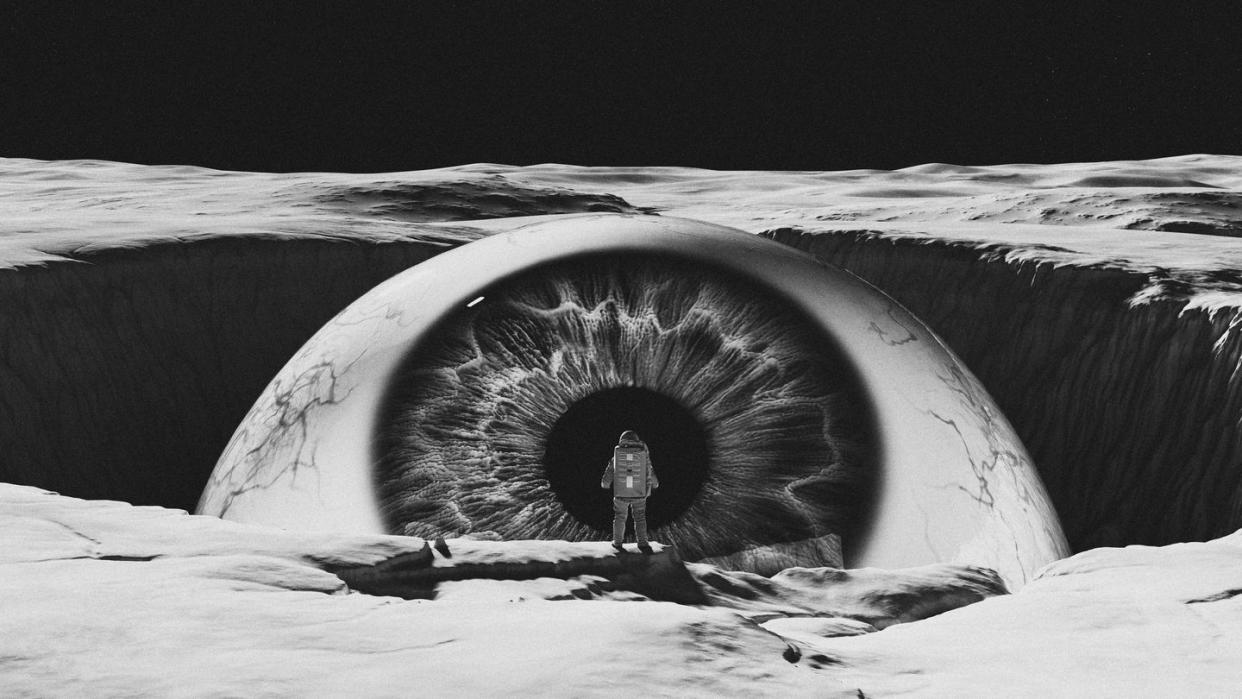
-
Discovered in 2017, some 48 light-years away, exoplanet LHS 1140 b was originally thought to be a mini-Neptune. But new research suggests that it’s actually a rocky super-Earth with possibly some pretty fascinating geography.
-
Because of its tidally locked position around its low-mass red dwarf star, this iceball planet could have a 2,500-mile-wide water “pupil,” giving the exoplanet the overall appearance of a lidless eye.
-
Despite its unsettling appearance, LHS 1140 b is currently a compelling candidate for finding liquid water beyond our Solar System.
The universe has no shortage of strange exoplanets. TOI-1798 c, for example, experiences an entire year in less than half an Earth day, WASP-130 b is distorted into the shape of a rugby ball, and a whole collection of exoplanets known as ‘Super-Puffs’ have densities similar to cotton candy. Now, a new weirdo is being added to this collection of space oddities—an eyeball super-Earth.
LHS 1140 b orbits around a low-density M-type main sequence star, otherwise known as a red dwarf, that’s roughly one-fifth the size of our Sun. Discovered some 48 light-years away from Earth in 2017, astronomers originally guessed that the exoplanet was a mini-Neptune, meaning it sported Neptune-like characteristics (a gas giant with a thick hydrogen-rich atmosphere) in a pint-sized package. But after analyzing new data from the James Webb Space Telescope (JWST)—along with ancillary data from Spitzer, Hubble, and TESS—astronomers from the Université de Montréal (UdeM) argue that the planet is actually a rocky super-Earth 5.6 times the mass of our home planet.
However, LHS 1140 b’s most startling characteristic is the melted, watery, 2,500-mile-wide “pupil” potentially residing on its surface, formed by its tidally-locked position with its host star. This means that, every 24 days, an unblinking eye, 1.7 times the size of Earth, finishes a complete rotation around its host star. The results of this study were published on the preprint server arXiv, and the paper has been accepted for publication in The Astrophysical Journal.
LHS 1140 b is incredibly close to its star, with an orbital radius of just about 9 percent of the distance from the Earth to the Sun, according to NASA. If our Sun, a G-type main sequence star, was replaced with LHS 1140, it’d absolutely roast the planet’s surface. But because the star is a cooler, low-mass red dwarf, this eyeball planet rests firmly within its “Goldilocks zone”—where temperatures are just right for liquid water to exist. Despite the exoplanet’s potentially strange appearance, astronomers are interested in this eyeball super-Earth for other important reasons.
“Of all currently known temperate exoplanets, LHS 1140 b could well be our best bet to one day indirectly confirm liquid water on the surface of an alien world beyond our Solar System,” Charles Cadieux, a Ph.D student at UdeM co-author of the study, said in a press statement. “This would be a major milestone in the search for potentially habitable exoplanets.”
To achieve this potentially major milestone, the team obtained extremely valuable “director’s discretionary time” (DDT) on JWST, which occurs when a time-critical observation is necessary—in this case, two transits of LHS 1140 b in December of 2023. The team analyzed the events using the telescope’s Near-Infrared Imager and Slitless Spectrograph (NIRISS) instrument (which is designed for exoplanet detection and transit spectroscopy, among other things), and ruled out the mini-Neptune theory while also discovering evidence of a nitrogen-rich atmosphere. This could mean that LHS 1140 b has a secondary atmosphere, something that usually forms after a planet has lost its thicker primary atmosphere.
The study also found that 10 to 20 percent of the exoplanet’s mass comes from water, meaning that the planet is likely a snowball world—with the lone exception of the aforementioned watery pupil where the exoplanet always faces its star. Conditions at the center of that watery ocean could even be quite pleasant, with the authors estimating a possible temperature at around 20 degrees Celsius.
These observations are currently tentative, so future glimpses at this star system will be necessary to firm up some of these details. But JWST’s examination of LHS 1140 b is a rare-but-powerful example of how the telescope can further our understanding of the numerous worlds beyond our Solar System.
“Detecting an Earth-like atmosphere on a temperate planet is pushing Webb’s capabilities to its limits—it’s feasible; we just need lots of observing time,” René Doyon, the supervising professor on the paper and principal investigator of the NIRISS instrument, said in a press statement. “The current hint of a nitrogen-rich atmosphere begs for confirmation with more data. We need at least one more year of observations to confirm that LHS 1140 b has an atmosphere, and likely two or three more to detect carbon dioxide.”
Sadly, it’s not easy for JWST to analyze this system, as only eight visits are possible every year. But future observations of LHS 1140 b will undoubtedly deliver some truly eye-opening discoveries.
You Might Also Like
https://ift.tt/t5FzgP8
Science
No comments:
Post a Comment